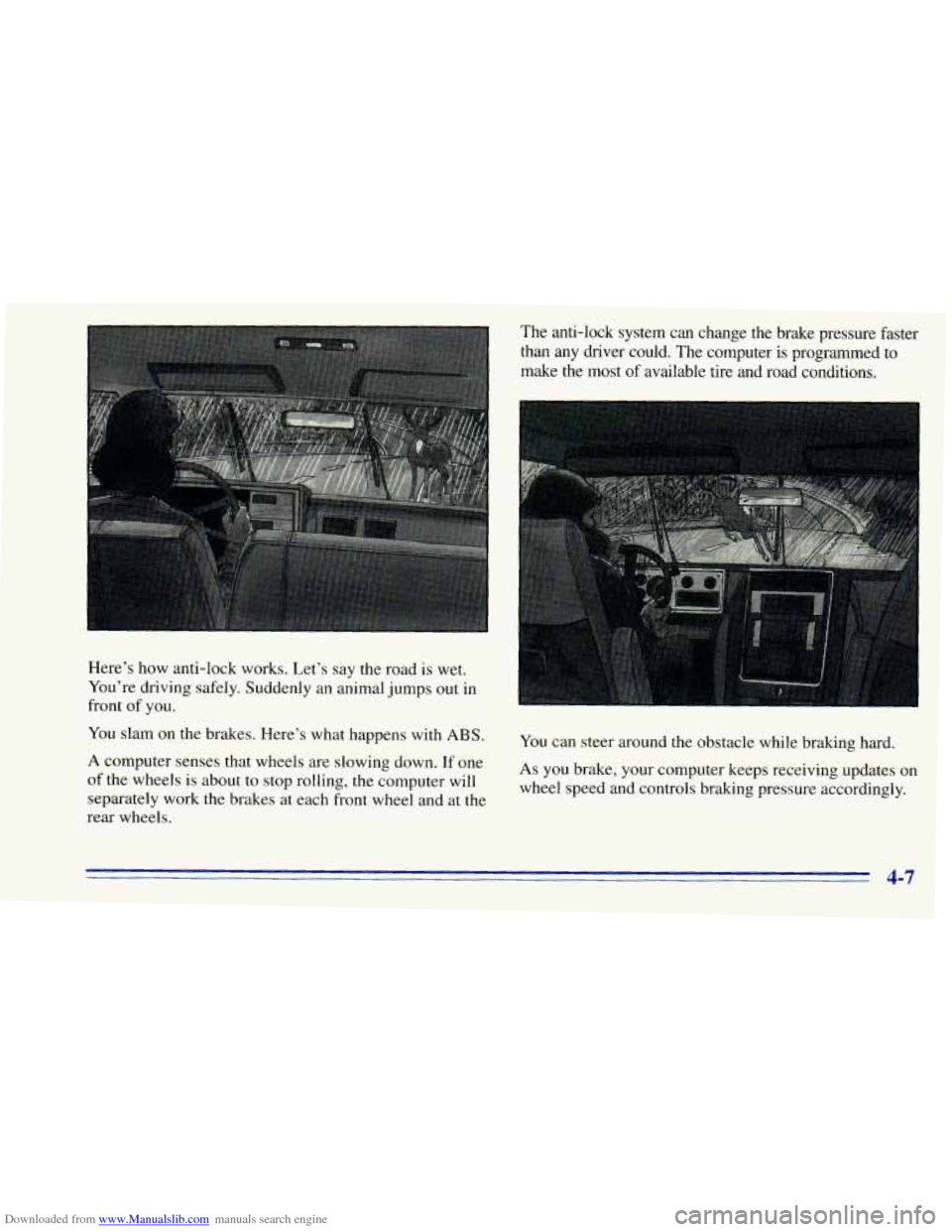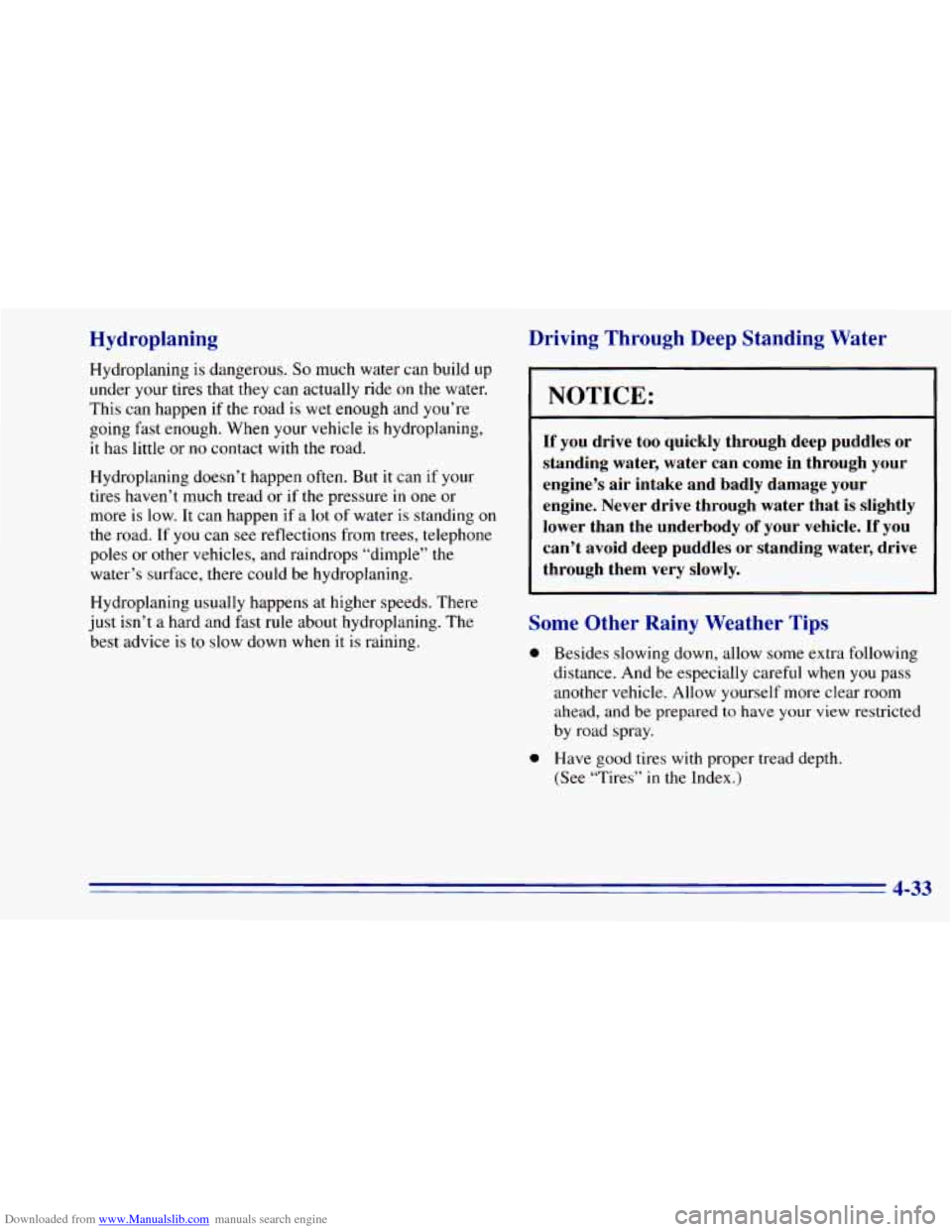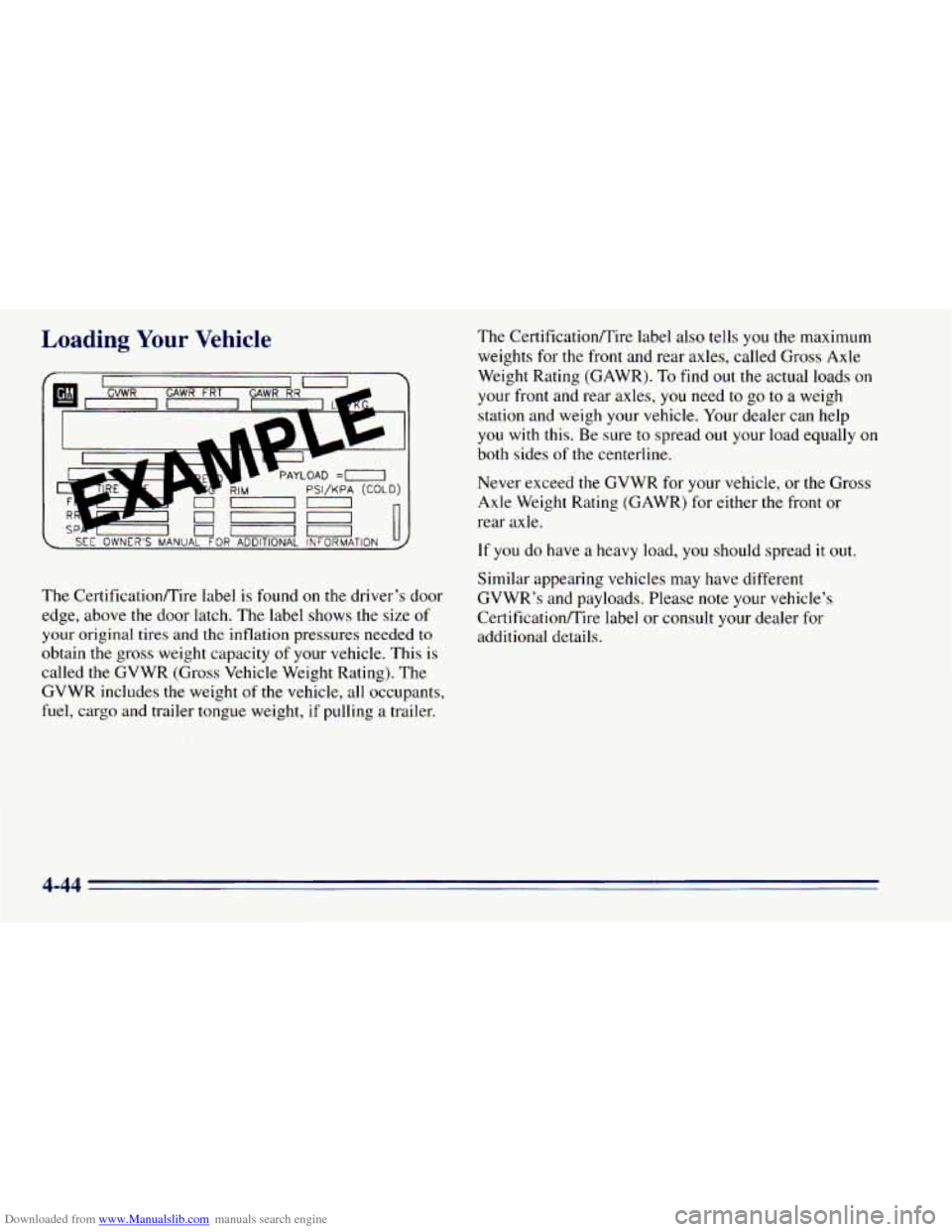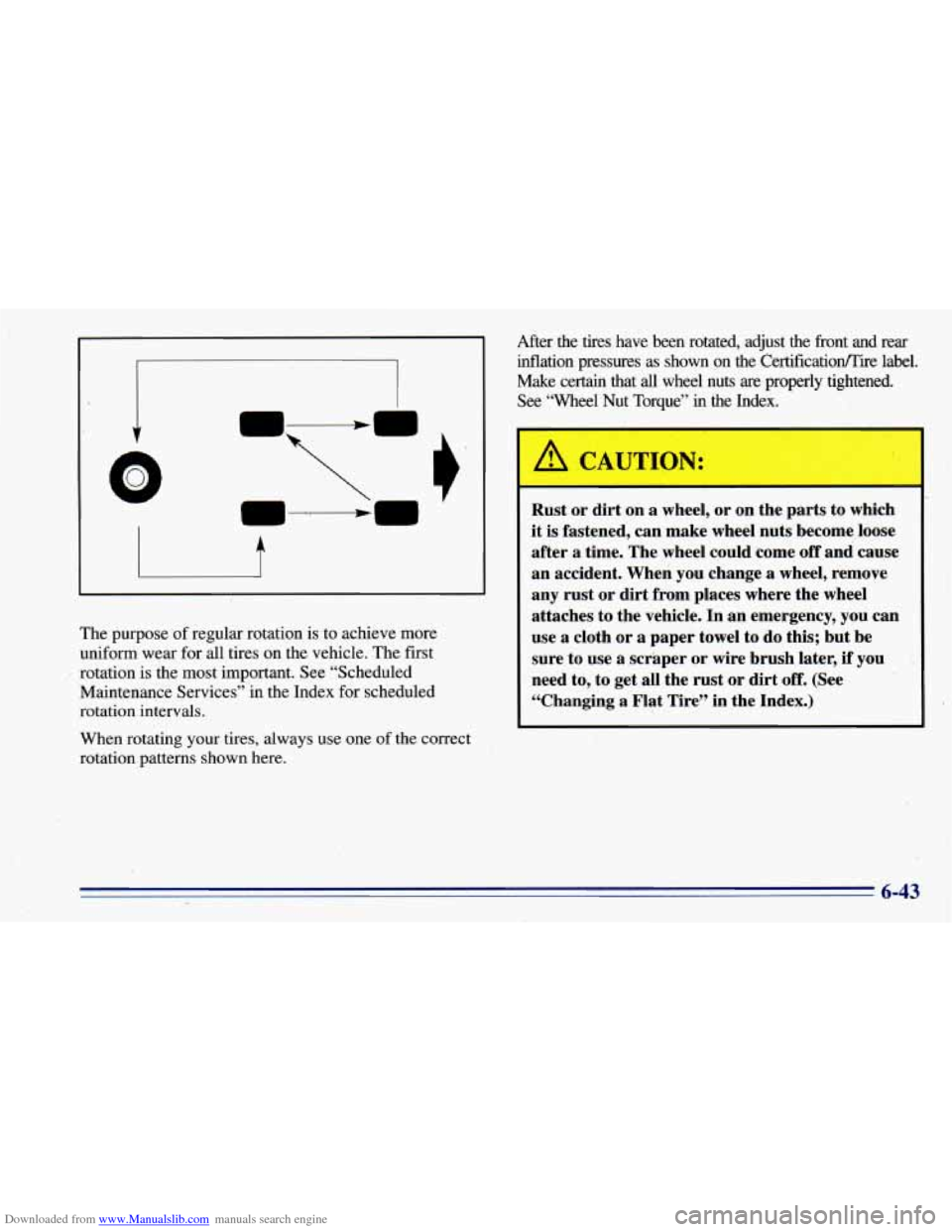1996 CHEVROLET BLAZER tire pressure
[x] Cancel search: tire pressurePage 161 of 392

Downloaded from www.Manualslib.com manuals search engine The anti-lock system can change the brake pressure faster
than any driver could. The computer
is programmed to
make the most
of available tire and road conditions.
Here’s how anti-lock works. Let’s say the road is wet.
You’re driving safely. Suddenly an animal jumps out in
front
of you.
You slam
on the brakes. Here’s what happens with ABS.
A computer senses that wheels are slowing down. If one
of the wheels
is about to stop rolling, the computer will
separately work the brakes at each front wheel and at the
rear wheels. You
can steer around the obstacle while braking hard. As you brake, your computer keeps receiving updates on
wheel speed and controls braking pressure accordingly.
4-7
Page 181 of 392

Downloaded from www.Manualslib.com manuals search engine Driving in Mud, Sand, Snow or Ice
When you drive in mud, snow or sand, your wheels
won’t get good traction. You can’t accelerate as
quickly, turning is more difficult, and you’ll need
longer braking distances.
It’s best to use
a low gear when you’re in mud -- the
deeper
the mud, the lower the gear. In really deep mud,
the idea is to keep your vehicle moving
so you don’t
get stuck.
When you drive on sand, you’ll sense
a change in wheel
traction. But it will depend upon how loosely packed the
sand
is. On loosely packed sand (as on beaches or sand
dunes) your tires
will tend to sink into the sand. This has
an effect
on steering, accelerating and braking. You may
want to reduce the air pressure
in your tires slightly
when driving on sand. This will improve traction. Hard
packed snow and ice offer the worst tire traction.
On these surfaces,
it’s very easy to lose control. On wet
ice, €or example, the traction is
so poor that you will
have difficulty accelerating. And if you do get moving,
poor steering and difficult braking can cause you to slide
out of control.
I
Driving on frozen lakes, ponds or rivers can be
dangerous. Underwater springs, currents under
the ice, or sudden thaws can weaken the ice. Your
vehicle could fall through the ice and you and
your passengers could drown. Drive your vehicle
on safe surfaces ‘only.
4-27
Page 187 of 392

Downloaded from www.Manualslib.com manuals search engine Hydroplaning
Hydroplaning is dangerous. So much water can build up
under your tires that they can actually ride on the water.
This can happen if the road is wet enough and you’re
going fast enough. When your vehicle is hydroplaning,
it has little or
no contact with the road.
Hydroplaning doesn’t happen often. But it can if your
tires haven’t much tread or if the pressure in
one or
more is low. It can happen if a
lot of water is standing on
the road. If you can see reflections from trees, telephone
poles or other vehicles, and raindrops “dimple” the
water’s surface, there could be hydroplaning.
Hydroplaning usually happens at higher speeds. There
just isn’t
a hard and fast rule about hydroplaning. The
best advice is
to slow down when it is raining.
Driving Through Deep Standing Water
NOTICE:
r
If you drive too quickly through deep puddles or
standing water, water can come in through your
engine’s air intake and badly damage your
engine. Never drive through water that
is slightly
lower than the underbody
of your vehicle. If you
can’t avoid deep puddles or standing water, drive
through them very slowly.
Some Other Rainy Weather Tips
0 Besides slowing down, allow some extra following
distance. And be especially careful when
you pass
another vehicle. Allow yourself more clear room
ahead, and
be prepared to have your view restricted
by road spray.
0 Have good tires with proper tread depth.
(See “Tires”
in the Index.)
4-33
Page 191 of 392

Downloaded from www.Manualslib.com manuals search engine Here are some things you can check before a trip:
0
a
0
0
0
0
0
Windshield Washer Fluid: Is the reservoir full?
Are all windows clean inside and outside?
Wiper Blades: Are they in good shape?
Fuel, Engine Oil, Other Fluids: Have you checked
all levels?
Lamps: Are they all working? Are the lenses clean?
Tires: They are vitally important to a safe,
trouble-free trip.
Is the tread good enough for
long-distance driving? Are the tires all inflated to the
recommended pressure?
Weather Forecasts: What’s the weather outlook
along your route? Should you delay your trip a short
time
to avoid a major storm system?
Maps: Do you have up-to-date maps?
Highway Hypnosis
Is there actually such a condition as “highway hypnosis”?
Or is
it just plain falling asleep at the wheel? Call it
highway hypnosis, lack of awareness,
or whatever.
There is something about an easy stretch
of road with the
same scenery, along with the hum of the tires on the road,
the drone
of the engine, and the rush of the wind against
the vehicle that can make
you sleepy. Don’t let it happen
to you!
If it does, your vehicle can leave the road in less
than n second, and you could crash and be injured.
What can
you do about highway hypnosis‘? First, be
aware that it can happen.
Then here are some tips:
0
0
0
Make sure your vehicle is well ventilated, with a
comfortably cool interior.
Keep your eyes moving. Scan the road ahead and
to
the sides. Check your mirrors and your instruments
frequently.
If
you get sleepy, pull off the road into a rest, service
or parking area and take a nap, get some exercise, or
both. For safety, treat drowsiness on the highway
as
an emergency.
4-37
Page 198 of 392

Downloaded from www.Manualslib.com manuals search engine Loading Your Vehicle
I *
‘GVWR VR F I
PAYLOAD =-I
PSI/KPA (COL
n
SEE OWNER’S MANUAL FOR ADDITIONAL INFORMATION I U
The Certificationnire label also tells you the maximum
weights for the front and rear axles, called Gross Axle
Weight Rating (GAWR). To find out the actual loads on
your front and rear axles, you need to go to a weigh
station and weigh your vehicle. Your dealer can help
you with this. Be sure to spread out your load equally on
both sides
of the centerline.
Never exceed the GVWR for your vehicle, or the Gross
Axle Weight Rating (GAWR) for either the front or
rear axle.
If you do have a heavy load, you should spread it out.
Similar appearing vehicles may have different
The Certificationrrire label is found on the driver’s door GVWR’s and payloads. \
Please note your vehicle’s
edge, above the door latch. The label shows the size of Certificationnire label or consult your dealer for
your
original tires and the inflation pressures needed to additional details.
obtain
the gross weight capacity of your vehicle. This is
called
the GVWR (Gross Vehicle Weight Rating). The
GVWR includes the weight of the vehicle, all occupants,
fuel, cargo and trailer tongue weight,
if pulling a trailer.
4-44
Page 289 of 392

Downloaded from www.Manualslib.com manuals search engine Poorly maintained and im
are dangerous. operly
used tires
0
0
0
0
Overloading your tires can cause
overheating
as a result of too much friction.
You could have an air-out and a serious
accident. See “Loading Your Vehicle” in
the Index.
Underinflated tires pose the same danger as
overloaded tires. The resulting accident
could cause serious injury. Check all tires
frequently to maintain the recommended
pressure. Tire pressure should be checked when your tires are cold.
Overinflated tires are more likely
to be
cut, punctured or broken by a sudden
impact
-- such as when you hit a pothole.
Keep tires at the recommended pressure.
Worn, old tires can cause accidents.
If your
tread
is badly worn, or if your tires have
been damaged, replace them.
Inflation - Tire Pressure
The Certificationmire label which is on the driver’s door
edge, above the door latch, shows the correct inflation
pressures for your tires
when they’re cold. “Cold”
means your vehicle has been sitting for
at least three
hours or driven
no more than a mile.
NOTICE:
Don’t let anyone tell you that underinflation or
overinflation is all right. It’s not.
If your tires
don’t have enough air (underinflation), you can
get the following:
0 Too much flexing
Too much heat
0 Tire overloading
0 Bad wear
Bad handling
Bad fuel economy.
NOTICE: (Continued)
6-41
Page 290 of 392

Downloaded from www.Manualslib.com manuals search engine NOTICE: (Continued)
If your tires have too much air (overinflation),
you can get the following:
Unusual wear
Bad handling
Rough ride
Needless damage from road hazards.
When
to Check
Check your tires once a month or more. Also, check the
tire pressure of the spare tire.
How to Check
Use a good quality pocket-type gage to check tire
pressure. You can’t tell if your tires are properly inflated
simply by looking at them. Radial tires may look
properly inflated even when they’re underinflated.
Be sure to put the valve caps back
on the valve stems.
They help prevent leaks by keeping
out dirt and moisture.
Tire Inspection and Rotation
Tires should be inspected every 6,000 to 8,000 miles
(10 000 to 13 000 km) for any signs of unusual wear., If
unusual wear is present, rotate your tires as soon as
possible and check wheel alignment. Also check for
damaged tires or wheels. See “When It’s Time for New
Tires” and “Wheel Replacement” later
in this section for
more information.
6-42
Page 291 of 392

Downloaded from www.Manualslib.com manuals search engine c
f
The purpose of regular rotation is to achieve more
uniform wear for all tires on the vehicle. The first
Maintenance Services” in the Index for scheduled
rotation intervals.
I rotation is the most important. See “Scheduled
When rotating your tires, always use one of the correct
rotation patterns shown here. After the tires have been rotated, adjust the front and rear
inflation pressures as shown on the
Certificatioflire label.
Make certain that
all wheel nuts are. properly tightened.
See “Wheel Nut Torque’’
in the Index.
Rust or dirt on
a wheel, or on .the parts to Which
it is fastened, can make wheel nuts become loose
after
a time. The wheel could come off and cause
an accident. When you change
a wheel, remove
any rust or dirt from places where the wheel
attaches to the vehicle. In an emergency, you can
use
a cloth or a paper towel to do this; but be
sure to use
a scraper or wire brush later, if you
need to, to get all the rust or dirt
off. (See
“Changing
a Flat Tire” in the Index.)
-_
6-43